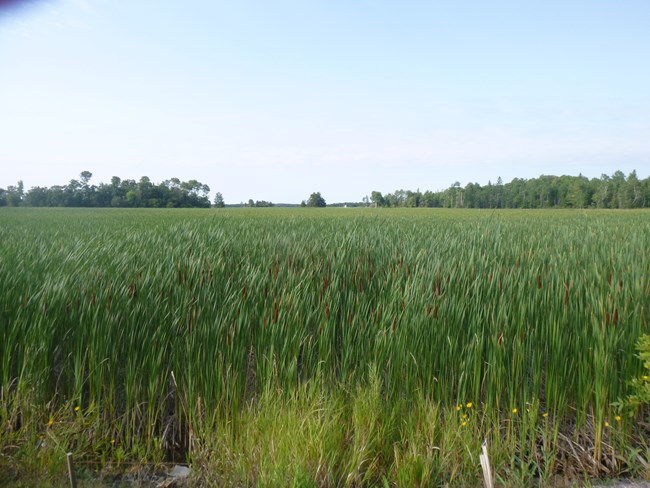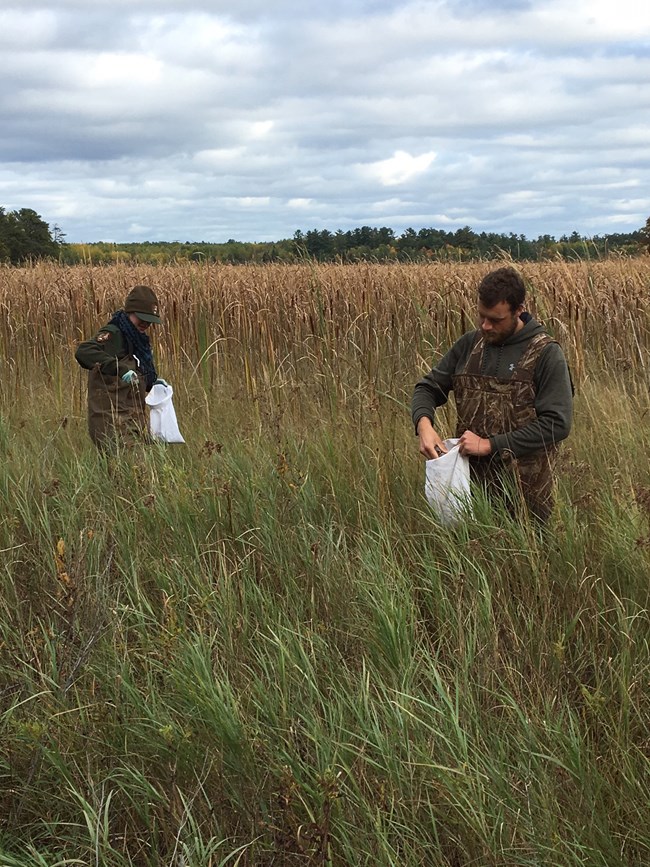
NPS Hybrid Cattail Damages the Ecosystem of Park WetlandsIn the past several decades, non-native cattail has taken over park wetlands, outcompeting native plants and changing habitat for fish and wetland animals. Today, nearly 500 acres of cattail make their homes here at Voyageurs. Over the next few years, park staff will work to remove invasive cattail and restore wetlands.Where did they come from?Although cattail has always inhabited wetlands of the Midwest, the variety we see today is not the same as the cattail that historically lived here. The current species of cattail is mostly a hybrid between Broadleaf cattail (Typha latifolia), a North American native, and non-native Narrowleaf cattail (Typha augustafolia). Narrowleaf cattail spread west across the country starting in the late 1800’s, cross-breeding with Broad-leaf cattail to form a hybrid more aggressive and stress tolerant than either parent. This new form of cattail, Typha x glauca, quickly established itself as a dominant wetland inhabitant.
NPS Why are the cattails a problem?Hybrid cattail begins to change the landscape of a wetland shortly after arriving. Although the seeds of the Typha x glauca are often sterile, they spread readily by rhizome, a root-like structure that grows horizontally, producing new shoots and creating mats that float on the water’s surface. These mats can be up to a meter thick, and dominate wetlands in dense monocultures.Native vegetation and aquatic wildlife in the park’s wetlands have suffered a decline in habitat as the result of hybrid cattail spreading. The rhizome grows aggressively, out-competing native vegetation. Wild rice (Zizania palustris) is among the native species affected, a plant iconic to northern Minnesota’s cultural history. Once established, the mat also prevents wildlife from accessing the water, making wetlands less desirable for species such as muskrats (Ondatra zibethicus), waterfowl, and rare and endangered birds. These mats also reduce habitat for fish, including spawning areas for northern pike (Esox lucius). 
NPS Management stepsRemoval of invasive cattail will be done over several years using a combination of methods. The lakes of Voyageurs National Park are designated “outstanding resource value waters,” which prohibits the use of chemical herbicides. Instead, mechanical removal and prescribed burning will be used to control exotic cattail. Mechanical removal began in fall 2017, which includes the use of aquatic cutting and harvesting machines, as well as removal by hand in smaller areas. Controlled burns are done to remove dead cattail stalks, reducing the amount of biomass in the wetland. Less biomass makes cattail removal easier for the cutting machines and stimulates the growth of native vegetation.After removal of the invasive cattail, wetlands will be restored and maintained in their natural state. The first step of restoration will be reseeding areas cattail has been removed from with seed from native vegetation. Park staff collected local seed stock to ensure plants that grow will not only be native, but adapted to conditions within the park. Long term, small areas may need to be treated again to prevent regrowth of cattail, and muskrats may play a role in helping maintain diverse wetlands. |
Last updated: July 10, 2018
